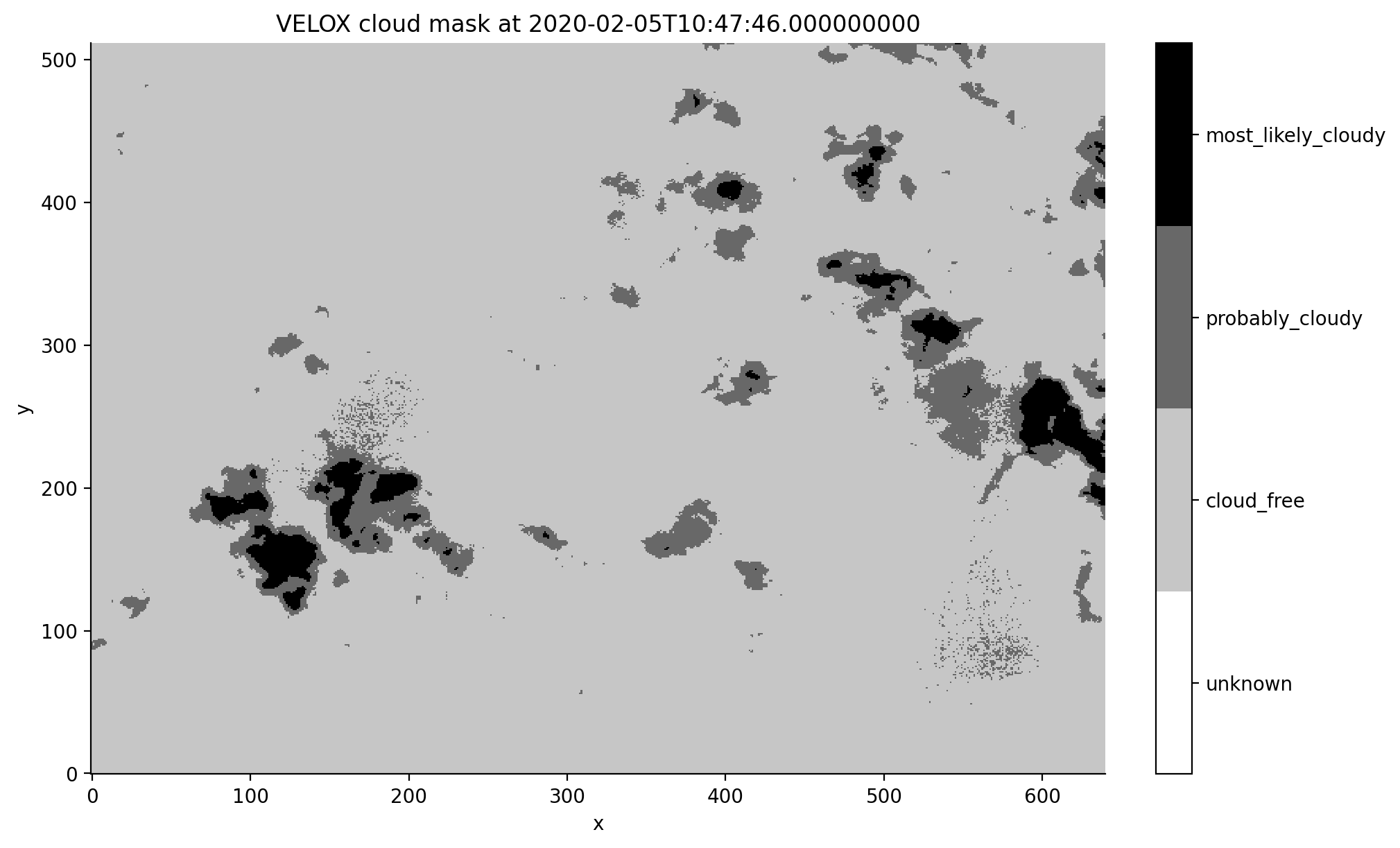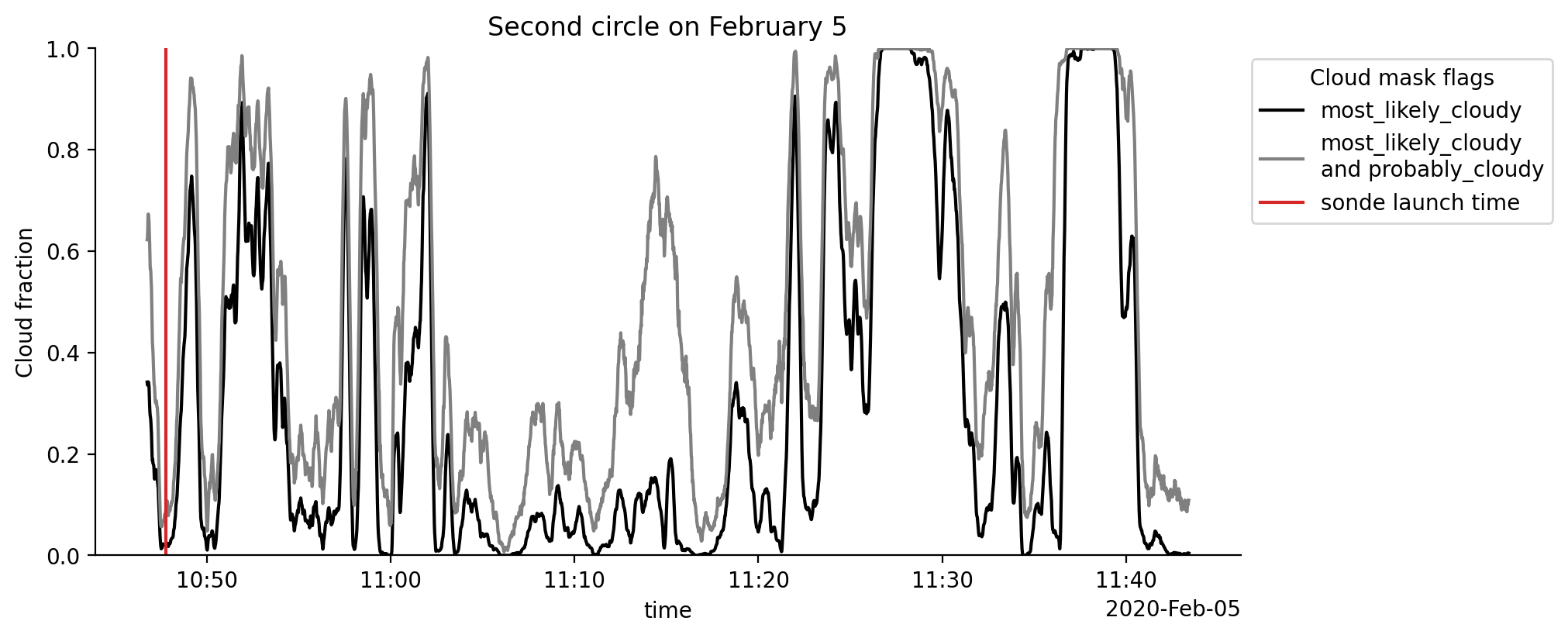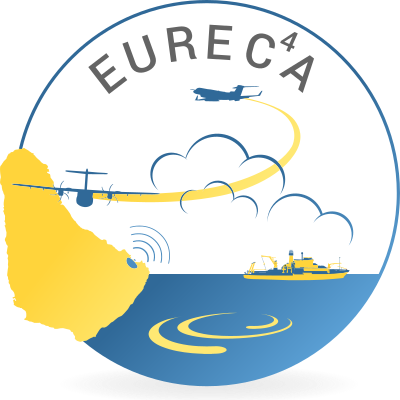VELOX#
Video airbornE Longwave Observations within siX channels
VELOX is a thermal infrared spectral imager (VELOX327k veL, 640 pixel by 512 pixels) with a synchronized filter wheel (at 100 Hz) covering six spectral channels in the thermal infrared wavelength range from 7.7 to 12.0 micrometer. The instrument measures the brightness temperature of upward radiance in a field-of-view of 35.49° by 28.71°.
The PI during EUREC⁴A was Michael Schäfer (University Leipzig).
If you have questions or if you would like to use the data for a publication, please don’t hesitate to get in contact with the dataset authors as stated in the dataset attributes contact or author.
Note
No data available for the transfer flights (first and last) and the first local research flight.
Get data#
To load the data we first load the EUREC⁴A intake catalog and list the available datasets from VELOX. Currently, there is a cloud mask product available.
import eurec4a
cat = eurec4a.get_intake_catalog(use_ipfs="QmahMN2wgPauHYkkiTGoG2TpPBmj3p5FoYJAq9uE9iXT9N")
list(cat.HALO.VELOX)
['cloudmask']
ds = cat.HALO.VELOX.cloudmask["HALO-0205"].to_dask()
ds
/home/runner/miniconda3/envs/how_to_eurec4a/lib/python3.13/site-packages/intake_xarray/base.py:21: FutureWarning: The return type of `Dataset.dims` will be changed to return a set of dimension names in future, in order to be more consistent with `DataArray.dims`. To access a mapping from dimension names to lengths, please use `Dataset.sizes`.
'dims': dict(self._ds.dims),
<xarray.Dataset> Size: 10GB
Dimensions: (time: 29894, y: 512, x: 640)
Coordinates:
alt (time) float32 120kB dask.array<chunksize=(29894,), meta=np.ndarray>
lat (time) float32 120kB dask.array<chunksize=(29894,), meta=np.ndarray>
lon (time) float32 120kB dask.array<chunksize=(29894,), meta=np.ndarray>
* time (time) datetime64[ns] 239kB 2020-02-05T09:21:46 ... 2020-02-0...
Dimensions without coordinates: y, x
Data variables:
CF_max (time) float32 120kB dask.array<chunksize=(29894,), meta=np.ndarray>
CF_min (time) float32 120kB dask.array<chunksize=(29894,), meta=np.ndarray>
cloud_mask (y, x, time) int8 10GB dask.array<chunksize=(32, 40, 3737), meta=np.ndarray>
vaa (y, x) float32 1MB dask.array<chunksize=(256, 320), meta=np.ndarray>
vza (y, x) float32 1MB dask.array<chunksize=(256, 320), meta=np.ndarray>
Attributes: (12/22)
Conventions: "CF-1.8"
author: Michael Schäfer, André Ehrlich, Anna Luebke, Jakob ...
campaign: EUREC4A
comment_1: The cloud mask is derived with 1 Hz temporal resolu...
comment_2: Four different thresholds (0.5 K, 1.0 K, 1.5 K, and...
comment_3: The final cloud mask logically combines the differe...
... ...
platform: HALO
research_flight_day: 20200205
source: Airborne imaging with the VELOX system
title: Two-dimensional cloud mask and cloud fraction with ...
variable: cloud_mask, CF_min, CF_max
version: Version 3 from 2021-02-12What does the VELOX image look like at a specific dropsonde launch?#
We can use the flight segmentation information to select a dropsonde and further extract the corresponding VELOX image taken at the time of the dropsonde launch.
In particular, we select the first dropsonde with the quality flag GOOD from the second circle on February 5.
Get dropsonde ID#
(0) we read the meta data and extract the segment IDs
meta = eurec4a.get_flight_segments()
segments = [{**s,
"platform_id": platform_id,
"flight_id": flight_id
}
for platform_id, flights in meta.items()
for flight_id, flight in flights.items()
for s in flight["segments"]
]
(1) we extract the segment ID of the second circle
import datetime
segments_ordered_by_start_time = list(sorted(segments, key=lambda s: s["start"]))
circles_Feb05 = [s["segment_id"]
for s in segments_ordered_by_start_time
if "circle" in s["kinds"]
and s["start"].date() == datetime.date(2020,2,5)
and s["platform_id"] == "HALO"
]
second_circle_Feb05 = circles_Feb05[1]
second_circle_Feb05
'HALO-0205_c2'
(2) we extract the ID of the first dropsonde with flag GOOD in this circle
segments_by_segment_id = {s["segment_id"]: s for s in segments}
first_dropsonde = segments_by_segment_id[second_circle_Feb05]["dropsondes"]["GOOD"][0]
first_dropsonde
'HALO-0205_s13'
What is the corresponding launch time of the selected sonde?#
So far, we only made use of the flight segmentation meta data. The launch time to a given sonde is stated in the JOANNE dataset (see also book chapter Dropsondes dataset JOANNE). We use again the intake catalog to load the JOANNE dataset and extract the launch time to the selected dropsonde by it’s sonde ID.
dropsondes = cat.dropsondes.JOANNE.level3.to_dask()
/home/runner/miniconda3/envs/how_to_eurec4a/lib/python3.13/site-packages/intake_xarray/base.py:21: FutureWarning: The return type of `Dataset.dims` will be changed to return a set of dimension names in future, in order to be more consistent with `DataArray.dims`. To access a mapping from dimension names to lengths, please use `Dataset.sizes`.
'dims': dict(self._ds.dims),
sonde_dt = dropsondes.sel(sonde_id=first_dropsonde).launch_time.values
sonde_dt
np.datetime64('2020-02-05T10:47:46.000000000')
Cloud mask plot#
Finally, we plot the VELOX image closest in time to the dropsonde launch.
The y-axis is in flight direction and the image consists of 640 pixel by 512 pixels. The corresponding pixel viewing sensor zenith and azimuth angles are given by the dataset variables vza and vaa.
ds_sel = ds.cloud_mask.sel(time=sonde_dt, method="nearest")
%matplotlib inline
import matplotlib.pyplot as plt
import pathlib
plt.style.use(pathlib.Path("./mplstyle/book"))
fig, ax = plt.subplots()
cax = ds_sel.plot(ax=ax,
cmap=plt.get_cmap('Greys', lut=4),
vmin=-1.5, vmax=2.5,
add_colorbar=False
)
cbar = fig.colorbar(cax, ticks=ds.cloud_mask.flag_values)
cbar.ax.set_yticklabels(ds.cloud_mask.flag_meanings.split(" "));
ax.set_title(f"VELOX cloud mask at {sonde_dt}");

What are the image cloud fraction lower and upper bounds?
cfmin = ds.CF_min.sel(time=sonde_dt, method="nearest").values
cfmax = ds.CF_max.sel(time=sonde_dt, method="nearest").values
print(f"Image minimum cloud fraction (most likely cloudy): {cfmin:.2f}")
print(f"Image maximum cloud fraction (most likely and probably cloudy) :{cfmax:.2f}")
Image minimum cloud fraction (most likely cloudy): 0.02
Image maximum cloud fraction (most likely and probably cloudy) :0.09
Cloud fraction time series from the second circle on February 5#
We also want to show a time series of cloud fraction and use the segment ID from the second circle to extract and save the segment information to the variable seg. We can later use the segments start and end times to select the data in time.
seg = segments_by_segment_id[second_circle_Feb05]
The dataset variable CF_min provides a lower bound to cloud fraction estimates based on the cloud mask flag most_likely_cloudy, while CF_max provides an upper bound by including the uncertain pixels labeled probably cloudy.
selection = ds.sel(time=slice(seg["start"], seg["end"]))
with plt.style.context("mplstyle/wide"):
fig, ax = plt.subplots()
selection.CF_min.plot(color="k", label="most_likely_cloudy")
selection.CF_max.plot(color="grey", label="most_likely_cloudy\nand probably_cloudy")
ax.axvline(sonde_dt, color="C3", label="sonde launch time")
ax.set_ylim(0, 1)
ax.set_ylabel("Cloud fraction")
ax.set_title("Second circle on February 5")
ax.legend(title="Cloud mask flags", bbox_to_anchor=(1,1), loc="upper left");



